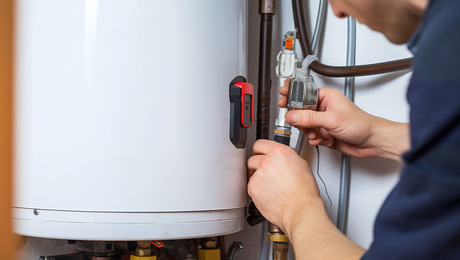Can you retro-fit venting to exisiting plumbing?
I have a 50 year old block and adobe house built on a slab. The slab rests on rock on a ridge top. Plumbing drains to a septic that had to be dynamited out of the rock ridge. Drain field was backfilled in. This is an old owner built house. He never installed any vent pipes to the plumbing. Two mail lines drain to the tank. The first is the kitchen. It gurgles a lot but does drain. The back two bathrooms, however, set up a back pressure when the toilets are flushed when full. This often causes gas to comes up through the p-traps on the other fixtures. Any hope for a retrofit?


















Replies
Of course you can retro-fit vents to an old plumbing system. You just need to have or make the room at the traps or line to install a vent line thru the roof, your minimum main vent will be 3in.i.d. From the sounds your system is making you need to get this done before you end up with major stoppages.
Here's the caveat on our old
Here's the caveat on our old house. There are no interior or exterior frame walls. Everything is concrete or adobe wall construction (including interior walls) with no place to chase the venting. In addition, to get to the bathtub, 2 sinks and one shower, there is no adjacent outside wall. this would mean tearing out the entire foundation, and slab to gain access to the elbows that lead to the septic tank. As i understand it, these have to be refitted with t-junctions so that each can vent through the roof. Without being able to bring a line from any of these up through a wall, I don't know where to run the vent lines. Outside the house?!
You will not need as many or as much venting as you might see in new homes. The codes, especially the Uniform Plumbing Code, have traditionally called for far more venting than is actually needed.
In a complete turnaround from requirements of past editions of the code, the UPC now allows for two entire bathroom groups to be vented with a single 2" vent. Certain requiremnts apply in that case, but my point is that you can probably accomplish the needed venting easier than you might think.
From your description, what you need most is a vent between the kitchen and bath drains. This will relieve the pressure created when the toilet is flushed and fills the line, pushing air ahead of the slug of water, and causing the kitchen to burp. This vent could be as small as 2".
Then, install an air admittance valve on the line under the bath sink and under the kitchen sink. An AAV is simply a one-way valve that allows air in, but keeps sewer gas out. They can fail over time, but are cheaply and easily replaced if you make sure you always have access to them, as under the sink cabinets.
You will still have to get creative in how you take the vent up and out the roof--like maybe starting it at the line that drains the bathroom sink, and running it over and up in a corner of the room where it could be hidden in a triangular cover.
If you vent the line under the bathroom sink, you would not need an AAV there--just one under the kitchen sink.
Thanks for the word of hope. I had understood that AAV valves needed to be installed above the fixtures, and without walls to put it in, I was out of luck. I also was told that they only move about 1.5 inches and don't provide reliable support.
Maybe I could get creative as to where to hide the vent lines inside - a 2" line is not bad but don't I need to install the line from a point close to the toilet line (inside the slab)?